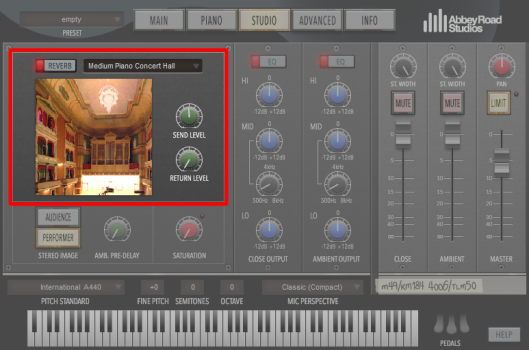
The CFX Concert Grand includes a convolution engine for high-quality sampled reverb. Convolution reverb uses impulse responses, which are the recorded reverberations of a space when an impulse sound is played within that space. The impulse responses are used to accurately reproduce the character of the space, including the imperfections and nuances that give the space its unique identity.
When you're using convolution reverb, you're effectively placing the piano in the sampled space. Lifelike reverb is an important part of any project, as it provides continuity of perception and authenticity to the listener.
Example: You're writing a piano concerto, and you want to hear what your piece would sound like in a full concert hall, so you add reverb, selecting the Medium Piano Concert Hall reverb preset. Because the orchestra is playing to a full house, you turn the Send Level knob down a touch, simulating the acoustic response of the hall being slightly damped by the large number of people standing in the aisles.
Turn reverb on or off so that you can easily hear the CFX Concert Grand with either no reverb or with the current reverb settings.
 .
. .
.The Reverb button works exactly like the bypass option commonly available to audio plug-ins.
Selecting a preset loads an impulse response, and a picture representing the space appears underneath the Reverb button.
Both knobs must be up in order to hear any reverb. If you're using a reverb preset of a larger space or concert hall, you may want to try combining reverb with a small amount of Ambient Pre-Delay and a lower ambient mic volume.

|